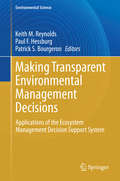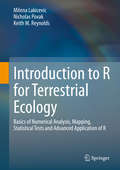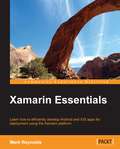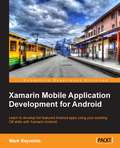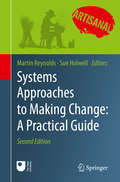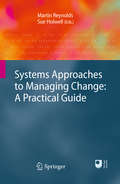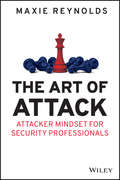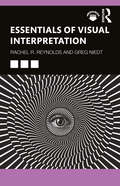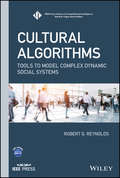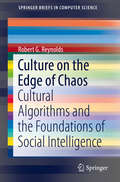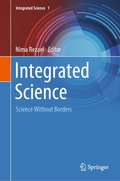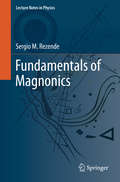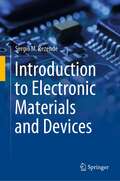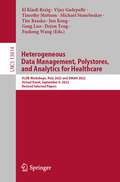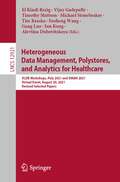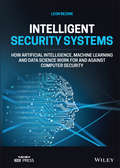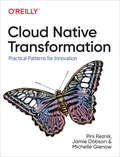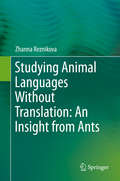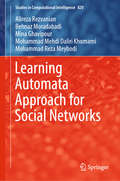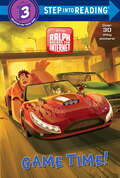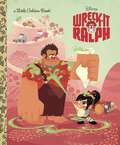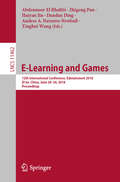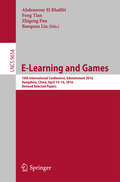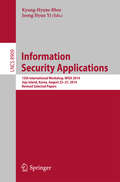- Table View
- List View
Theories of Programming Languages
by John C. ReynoldsThis textbook is a broad but rigorous survey of the theoretical basis for the design, definition, and implementation of programming languages, and of systems for specifying and proving program behavior. It encompasses imperative and functional programming, as well as the ways of integrating these aspects into more general languages. Basic concepts and their properties are described with mathematical rigor, but the mathematical development is balanced by numerous examples of applications, particularly of program specification and proof, concurrent programming, functional programming (including the use of continuations and lazy evaluation), and type systems (including subtyping, polymorphism, and modularization). Assuming only knowledge of elementary programming, this text is perfect for advanced undergraduate and beginning graduate courses in programming language theory, and will also appeal to researchers and professionals in designing or implementing computer languages.
Making Transparent Environmental Management Decisions
by Keith M. Reynolds Paul F. Hessburg Patrick S. BourgeronSince 1997, the Ecosystem Management Decision Support (EMDS) system has been used around the world to support environmental analysis and planning in many different application areas, and it has been applied over a wide range of geographic scales, from forest stands to entire countries. An extensive sampling of this diversity of applications is presented in section 2, in which EMDS application developers describe the varied uses of the system. These accounts, together with the requisite background in section 1, provide valuable practical insights into how the system can be applied in the general domain of environmental management.
Introduction to R for Terrestrial Ecology: Basics of Numerical Analysis, Mapping, Statistical Tests and Advanced Application of R
by Keith M. Reynolds Milena Lakicevic Nicholas PovakThis textbook covers R data analysis related to environmental science, starting with basic examples and proceeding up to advanced applications of the R programming language. The main objective of the textbook is to serve as a guide for undergraduate students, who have no previous experience with R, but part of the textbook is dedicated to advanced R applications, and will also be useful for Masters and PhD students, and professionals. The textbook deals with solving specific programming tasks in R, and tasks are organized in terms of gradually increasing R proficiency, with examples getting more challenging as the chapters progress. The main competencies students will acquire from this textbook are: manipulating and processing data tablesperforming statistical testscreating maps in R This textbook will be useful in undergraduate and graduate courses in Advanced Landscape Ecology, Analysis of Ecological and Environmental Data, Ecological Modeling, Analytical Methods for Ecologists, Statistical Inference for Applied Research, Elements of Statistical Methods, Computational Ecology, Landscape Metrics and Spatial Statistics.
Xamarin Essentials
by Mark ReynoldsIf you are an experienced iOS and Android developer and have a desire to learn about the Xamarin platform, then you will find this tutorial to be the most efficient, interesting, and relevant path. You will find this guide to be especially useful if you wish to become proficient in creating apps using the Xamarin platform, as Xamarin Essentials teaches you the fundamentals of iOS and Android development.
Xamarin Mobile Application Development for Android
by Mark ReynoldsA step-by-step tutorial that follows the development of a simple Android app from end to end, through troubleshooting, and then distribution. The language used assumes a knowledge of basic C#. If you are a C# developer with a desire to develop Android apps and want to enhance your existing skill set, then this book is for you. It is assumed that you have a good working knowledge of C#, .NET, and object-oriented software development. Familiarity with rich client technologies such as WPF or Silverlight is also helpful, but not required.
Systems Approaches to Making Change: A Practical Guide
by Martin Reynolds Sue HolwellThe five approaches outlined in this book offers the systems thinking practitioner a range of interchangeable tools for pro-actively making systemic improvements amidst complex situations of change and uncertainty. Practitioners from all professional domains are increasingly confronted with incidences of systemic failure, yet poorly equipped with appropriate tools and know-how for understanding such failure, and the making of systemic improvement. In our fragile Anthropocene world where ‘systems change’ is often invoked as the rallying call for purposeful alternative action, this book provides a toolkit to help constructively make systems that can change situations for the better. Systems Approaches offers an excellent introduction for those seeking to understand systems thinking and to enact systems thinking in practice. The book helps practitioners from all professions to better understand inter-relationships, engage with multiple perspectives, and reflect on boundary judgements that can inhibit or enhance improved purposeful change. After an editorial introduction to these systems thinking in practice capabilities, successive chapters illustrate five systems approaches, each chosen for having a rigorous though adaptable framework, and a robust long pedigree of application in complex situations. Each chapter illustrates what the approach is about, followed by invaluable tips and insights from experience regarding how the tools might be practiced. Amongst updates from originating authors for this 2nd edition, each approach has an accompanying postscript on some developments since the 1st edition.
Systems Approaches to Managing Change: A Practical Guide
by Martin Reynolds Sue HolwellIn a world of increasing complexity, instant information availability and constant flux, systems approaches provide the opportunity of a tangible anchor of purpose and iterate learning. The five approaches outlined in the book offer a range of interchangeable tools with rigorous frameworks of application tried and tested in the 'real world'. The frameworks of each approach form a powerful toolkit to explore the dynamics of how societies emerge, how organisations create viability, how to facilitate chains of argument through causal mapping, how to embrace a multiplicity of perspectives identifying purposeful activity and how to look for the bigger picture across multiple disciplines. Systems Approaches offers an excellent first introduction for those seeking to understand what 'systems thinking' is all about as well as why the tools discussed herein should be applied to management and professional practice. This book provides a practical guide, and the chapters stand alone in explaining and developing each approach.
The Art of Attack: Attacker Mindset for Security Professionals
by Maxie ReynoldsTake on the perspective of an attacker with this insightful new resource for ethical hackers, pentesters, and social engineers In The Art of Attack: Attacker Mindset for Security Professionals, experienced physical pentester and social engineer Maxie Reynolds untangles the threads of a useful, sometimes dangerous, mentality. The book shows ethical hackers, social engineers, and pentesters what an attacker mindset is and how to and how to use it to their advantage. Adopting this mindset will result in the improvement of security, offensively and defensively, by allowing you to see your environment objectively through the eyes of an attacker. The book shows you the laws of the mindset and the techniques attackers use, from persistence to “start with the end” strategies and non-linear thinking, that make them so dangerous. You’ll discover: A variety of attacker strategies, including approaches, processes, reconnaissance, privilege escalation, redundant access, and escape techniques The unique tells and signs of an attack and how to avoid becoming a victim of one What the science of psychology tells us about amygdala hijacking and other tendencies that you need to protect against Perfect for red teams, social engineers, pentesters, and ethical hackers seeking to fortify and harden their systems and the systems of their clients, The Art of Attack is an invaluable resource for anyone in the technology security space seeking a one-stop resource that puts them in the mind of an attacker.
Essentials of Visual Interpretation
by Rachel R Reynolds Greg NiedtEssentials of Visual Interpretation explains how to talk and write critically about visual media and to examine how evolving visual environments, media, and technologies affect human selfunderstanding and culture formation.Lively and accessibly written chapters provide a solid foundation in the tools and ideas of visual meaning, familiarizing readers with a growing, cross-cultural subfield, and preparing them to pursue thoughtful work in a variety of related disciplines. The authors include rich examples and illustrations—ranging from cave paintings to memes, from optical science to visual analytics, from ancient pictographs to smart phones—that engage students with the fascinating complexity of visual interpretation. Each chapter introduces students to key terms and concepts relevant to visual analysis, with ideas for short individual or group exercises to enhance understanding.The book is ideal as a primer in visual analysis and visual communication for students in courses within communication studies, cultural studies, digital humanities, semiotics, media studies, and visual anthropology.Online support materials include multimedia activities for students and links to additional resources for students and instructors.
Cultural Algorithms: Tools to Model Complex Dynamic Social Systems (IEEE Press Series on Computational Intelligence)
by Robert G. ReynoldsA thorough look at how societies can use cultural algorithms to understand human social evolution For those working in computational intelligence, developing an understanding of how cultural algorithms and social intelligence form the essential framework for the evolution of human social interaction is essential. This book, Cultural Algorithms: Tools to Model Complex Dynamic Social Systems, is the foundation of that study. It showcases how we can use cultural algorithms to organize social structures and develop socio-political systems that work. For such a vast topic, the text covers everything from the history of the development of cultural algorithms and the basic framework with which it was organized. Readers will also learn how other nature-inspired algorithms can be expressed and how to use social metrics to assess the performance of various algorithms. In addition to these topics, the book covers topics including: ● The CAT system including the Repast Simphony System and CAT Sample Runs ● How to problem solve using social networks in cultural algorithms with auctions ● Understanding Common Value Action to enhance Social Knowledge Distribution Systems ● Case studies on team formations ● An exploration of virtual worlds using cultural algorithms For industry professionals or new students, Cultural Algorithms provides an impactful and thorough look at both social intelligence and how human social evolution translates into the modern world.
Culture on the Edge of Chaos: Cultural Algorithms And The Foundations Of Social Intelligence (SpringerBriefs in Computer Science)
by Robert G. ReynoldsThe author first introduces the basic framework for cultural algorithms and he then explains the social structure of a cultural system as a mechanism for the distribution of problem-solving information throughout a population. Three different models for social organizations are presented: the homogeneous (nuclear family), heterogeneous (expanded family), and subculture (descent groups) social models. The chapters that follow compare the learning capabilities of these social organizations relative to problems of varying complexity. The book concludes with a discussion of how the results can impact our understanding of social evolution.
Integrated Science: Science Without Borders (Integrated Science #1)
by Nima RezaeiThe “INTEGRATED SCIENCE: Science without Borders” is the first volume of INTEGRATED SCIENCE Book series, aims to publish the results of the most update ideas and reviews in transdisciplinarity fields, to highlight integration of different disciplines, including formal sciences, physical-chemical sciences and engineering, biological sciences, medical sciences, and social sciences. This is especially focused on the research involving the integration of two of more academic fields offering an innovative view, which is one of the main focuses of Universal Scientific Education and Research Network (USERN); science without borders. The whole world is suffering from complex problems; these are actually borderless problems; so, borderless solution could be the solution for such complex problems. Transdisciplinarity, as a domain that researchers work jointly, using shared conceptual framework drawing together disciplinary-specific theories, concepts and approaches to address common problem. Lack of confidence, lack of expertise, complexities of healthcare, the confusing nature of healthcare environments and lack of organization and standardization became obstacles to successful communication. Consequently, the book is to provide an overview of the basic elements of transdisciplinary studies and integrated science. The unique aspect of this book, privileging it from other books, is covering all aspects of science as a true one nature.
Fundamentals of Magnonics (Lecture Notes in Physics #969)
by Sergio M. RezendeFundamentals of Magnonics is a textbook for beginning graduate students in the areas of magnetism and spintronics. The level of presentation assumes only basic knowledge of the origin of magnetism and electromagnetism, and quantum mechanics. The book utilizes elementary mathematical derivations, aimed mainly at explaining the physical concepts involved in the phenomena studied and enabling a deeper understanding of the experiments presented. Key topics include the basic phenomena of ferromagnetic resonance in bulk materials and thin films, semi-classical theory of spin waves, quantum theory of spin waves and magnons, magnons in antiferromagnets, parametric excitation of magnons, nonlinear and chaotic phenomena, Bose-Einstein condensation of magnons, and magnon spintronics. Featuring end-of-chapter problem sets accompanied by extensive contemporary and historical references, this book provides the essential tools for any graduate or advanced undergraduate-level course of studies on the emerging field of magnonics.
Introduction to Electronic Materials and Devices
by Sergio M. RezendeThis textbook lays out the fundamentals of electronic materials and devices on a level that is accessible to undergraduate engineering students with no prior coursework in electromagnetism and modern physics. The initial chapters present the basic concepts of waves and quantum mechanics, emphasizing the underlying physical concepts behind the properties of materials and the basic principles of device operation. Subsequent chapters focus on the fundamentals of electrons in materials, covering basic physical properties and conduction mechanisms in semiconductors and their use in diodes, transistors, and integrated circuits. The book also deals with a broader range of modern topics, including magnetic, spintronic, and superconducting materials and devices, optoelectronic and photonic devices, as well as the light emitting diode, solar cells, and various types of lasers. The last chapter presents a variety of materials with specific novel applications, such as dielectric materials used in electronics and photonics, liquid crystals, and organic conductors used in video displays, and superconducting devices for quantum computing.Clearly written with compelling illustrations and chapter-end problems, Rezende’s Introduction to Electronic Materials and Devices is the ideal accompaniment to any undergraduate program in electrical and computer engineering. Adjacent students specializing in physics or materials science will also benefit from the timely and extensive discussion of the advanced devices, materials, and applications that round out this engaging and approachable textbook.
Heterogeneous Data Management, Polystores, and Analytics for Healthcare: VLDB Workshops, Poly 2022 and DMAH 2022, Virtual Event, September 9, 2022, Revised Selected Papers (Lecture Notes in Computer Science #13814)
by El Kindi Rezig Vijay Gadepally Timothy Mattson Michael Stonebraker Tim Kraska Jun Kong Gang Luo Dejun Teng Fusheng WangThis book constitutes revised selected papers from two VLDB workshops: The International Workshop on Polystore Systems for Heterogeneous Data in Multiple Databases with Privacy and Security Assurances, Poly 2022, and the 8th International Workshop on Data Management and Analytics for Medicine and Healthcare, DMAH 2022, which were held virtually on September 9, 2022. The proceedings include 3 full papers each from Poly 2022 and from DMAH 2022. DMAH deals with innovative data management and analytics technologies highlighting end-to-end applications, systems, and methods to address problems in healthcare, public health, and everyday wellness, with clinical, physiological, imaging, behavioral, environmental, and omic - data, and data from social media and the Web.Poly is focusing on the broader real-world polystore problem, which includes data management, data integration, data curation, privacy, and security.
Heterogeneous Data Management, Polystores, and Analytics for Healthcare: VLDB Workshops, Poly 2021 and DMAH 2021, Virtual Event, August 20, 2021, Revised Selected Papers (Lecture Notes in Computer Science #12921)
by El Kindi Rezig Vijay Gadepally Timothy Mattson Michael Stonebraker Tim Kraska Fusheng Wang Gang Luo Jun Kong Alevtina DubovitskayaThis book constitutes revised selected papers from two VLDB workshops: The International Workshop on Polystore Systems for Heterogeneous Data in Multiple Databases with Privacy and Security Assurances, Poly 2021, and the 7th International Workshop on Data Management and Analytics for Medicine and Healthcare, DMAH 2021, which were held virtually on August 2021. For Poly 2021, 7 full and 2 short papers were accepted from 10 submissions; and for DMAH 2021, 4 full papers together with 2 invited papers were accepted from a total of 7 submissions. The papers were organized in topical sections as follows: distributed information systems in enterprises, enterprise access to data constructed from a variety of programming models, data management, data integration, data curation, privacy, and security innovative data management and analytics technologies highlighting end-to-end applications, systems, and methods to address problems in healthcare.
Intelligent Security Systems: How Artificial Intelligence, Machine Learning and Data Science Work For and Against Computer Security
by Leon ReznikINTELLIGENT SECURITY SYSTEMS Dramatically improve your cybersecurity using AI and machine learning In Intelligent Security Systems, distinguished professor and computer scientist Dr. Leon Reznik delivers an expert synthesis of artificial intelligence, machine learning and data science techniques, applied to computer security to assist readers in hardening their computer systems against threats. Emphasizing practical and actionable strategies that can be immediately implemented by industry professionals and computer device’s owners, the author explains how to install and harden firewalls, intrusion detection systems, attack recognition tools, and malware protection systems. He also explains how to recognize and counter common hacking activities. This book bridges the gap between cybersecurity education and new data science programs, discussing how cutting-edge artificial intelligence and machine learning techniques can work for and against cybersecurity efforts. Intelligent Security Systems includes supplementary resources on an author-hosted website, such as classroom presentation slides, sample review, test and exam questions, and practice exercises to make the material contained practical and useful. The book also offers: A thorough introduction to computer security, artificial intelligence, and machine learning, including basic definitions and concepts like threats, vulnerabilities, risks, attacks, protection, and tools An exploration of firewall design and implementation, including firewall types and models, typical designs and configurations, and their limitations and problems Discussions of intrusion detection systems (IDS), including architecture topologies, components, and operational ranges, classification approaches, and machine learning techniques in IDS design A treatment of malware and vulnerabilities detection and protection, including malware classes, history, and development trends Perfect for undergraduate and graduate students in computer security, computer science and engineering, Intelligent Security Systems will also earn a place in the libraries of students and educators in information technology and data science, as well as professionals working in those fields.
Cloud Native Transformation: Practical Patterns for Innovation
by Pini Reznik Jamie Dobson Michelle GienowIn the past few years, going cloud native has been a big advantage for many companies. But it’s a tough technique to get right, especially for enterprises with critical legacy systems. This practical hands-on guide examines effective architecture, design, and cultural patterns to help you transform your organization into a cloud native enterprise—whether you’re moving from older architectures or creating new systems from scratch.By following Wealth Grid, a fictional company, you’ll understand the challenges, dilemmas, and considerations that accompany a move to the cloud. Technical managers and architects will learn best practices for taking on a successful company-wide transformation.Cloud migration consultants Pini Reznik, Jamie Dobson, and Michelle Gienow draw patterns from the growing community of expert practitioners and enterprises that have successfully built cloud native systems. You’ll learn what works and what doesn’t when adopting cloud native—including how this transition affects not just your technology but also your organizational structure and processes.You’ll learn:What cloud native means and why enterprises are so interested in itCommon barriers and pitfalls that have affected other companies (and how to avoid them)Context-specific patterns for a successful cloud native transformationHow to implement a safe, evolutionary cloud native approachHow companies addressed root causes and misunderstandings that hindered their progressCase studies from real-world companies that have succeeded with cloud native transformations
Studying Animal Languages Without Translation: An Insight from Ants
by Zhanna ReznikovaThe Author of this new volume on ant communication demonstrates that information theory is a valuable tool for studying the natural communication of animals. To do so, she pursues a fundamentally new approach to studying animal communication and “linguistic” capacities on the basis of measuring the rate of information transmission and the complexity of transmitted messages.Animals’ communication systems and cognitive abilities have long-since been a topic of particular interest to biologists, psychologists, linguists, and many others, including researchers in the fields of robotics and artificial intelligence. The main difficulties in the analysis of animal language have to date been predominantly methodological in nature. Addressing this perennial problem, the elaborated experimental paradigm presented here has been applied to ants, and can be extended to other social species of animals that have the need to memorize and relay complex “messages”. Accordingly, the method opens exciting new dimensions in the study of natural communications in the wild.
Learning Automata Approach for Social Networks (Studies in Computational Intelligence #820)
by Alireza Rezvanian Behnaz Moradabadi Mina Ghavipour Mohammad Mehdi Daliri Khomami Mohammad Reza MeybodiThis book begins by briefly explaining learning automata (LA) models and a recently developed cellular learning automaton (CLA) named wavefront CLA. Analyzing social networks is increasingly important, so as to identify behavioral patterns in interactions among individuals and in the networks’ evolution, and to develop the algorithms required for meaningful analysis. As an emerging artificial intelligence research area, learning automata (LA) has already had a significant impact in many areas of social networks. Here, the research areas related to learning and social networks are addressed from bibliometric and network analysis perspectives. In turn, the second part of the book highlights a range of LA-based applications addressing social network problems, from network sampling, community detection, link prediction, and trust management, to recommender systems and finally influence maximization. Given its scope, the book offers a valuable guide for all researchers whose work involves reinforcement learning, social networks and/or artificial intelligence.
Game Time! (Step into Reading)
by RH DisneyA Step 3 deluxe Step into Reading leveled reader is based on the new Disney Ralph Breaks the Internet: Wreck-It Ralph 2!Walt Disney Animation Studios' follow-up to 2012's Wreck-It Ralph leaves the arcade behind, venturing into the expansive universe of the internet--which may or may not survive Ralph's not-so-light touch. Produced by Oscar® winner Clark Spencer, Ralph Breaks the Internet: Wreck-It Ralph 2 hits theaters on November 21, 2018! This Step 3 Step into Reading leveled reader with stickers is based on the upcoming feature film. It's perfect for children ages 5 to 7! Step 3 readers feature engaging characters in easy-to-follow plots about popular topics. For children who are ready to read on their own.
Wreck-It Ralph Little Golden Book (Little Golden Book)
by RH DisneyDisney's Wreck-It Ralph is a computer-animated feature film about a misunderstood video game villain who wants nothing more than to be the good guy for a change. But when Ralph finally gets his chance, will it mean "Game Over" for every game in the arcade? Young fans ages 2-5 will love this full-color Little Golden Book version of the movie.
E-Learning and Games: 12th International Conference, Edutainment 2018, Xi'an, China, June 28–30, 2018, Proceedings (Lecture Notes in Computer Science #11462)
by Abdennour El Rhalibi Zhigeng Pan Haiyan Jin Dandan Ding Andres A. Navarro-Newball Yinghui WangThis book constitutes the refereed proceedings of the 12th International Conference on e-Learning and Games, EDUTAINMENT 2018, held in Xi’an, China, in June 2018. The 32 full and 32 short papers presented in this volume were carefully reviewed and selected from 85 submissions. The papers were organized in topical sections named: virtual reality and augmented reality in edutainment; gamification for serious game and training; graphics, imaging and applications; game rendering and animation; game rendering and animation and computer vision in edutainment; e-learning and game; and computer vision in edutainment.
E-Learning and Games
by Abdennour El Rhalibi Feng Tian Zhigeng Pan Baoquan LiuThis book constitutes the refereed proceedings of the 10th International Conference on E-Learning and Games, Edutainment 2016, held in Hangzhou, China, in April 2016. The 36 full papers presented were carefully reviewed and selected from 60 submissions. They are organized in the following topical sections: E-learning and game; graphics, imaging and applications; intelligent data analytics and visualization.
Information Security Applications
by Kyung-Hyune Rhee Jeong Hyun YiThis book constitutes the thoroughly refereed proceedings of the 15th International Workshop on Information Security Applications, WISA 2014, held on Jeju Island, Korea, in August 2014. The 30 revised full papers presented in this volume were carefully reviewed and selected from 69 submissions. The papers are organized in topical sections such as malware detection; mobile security; vulnerability analysis; applied cryptography; network security; cryptography; hardware security; and critical infrastructure security and policy.

